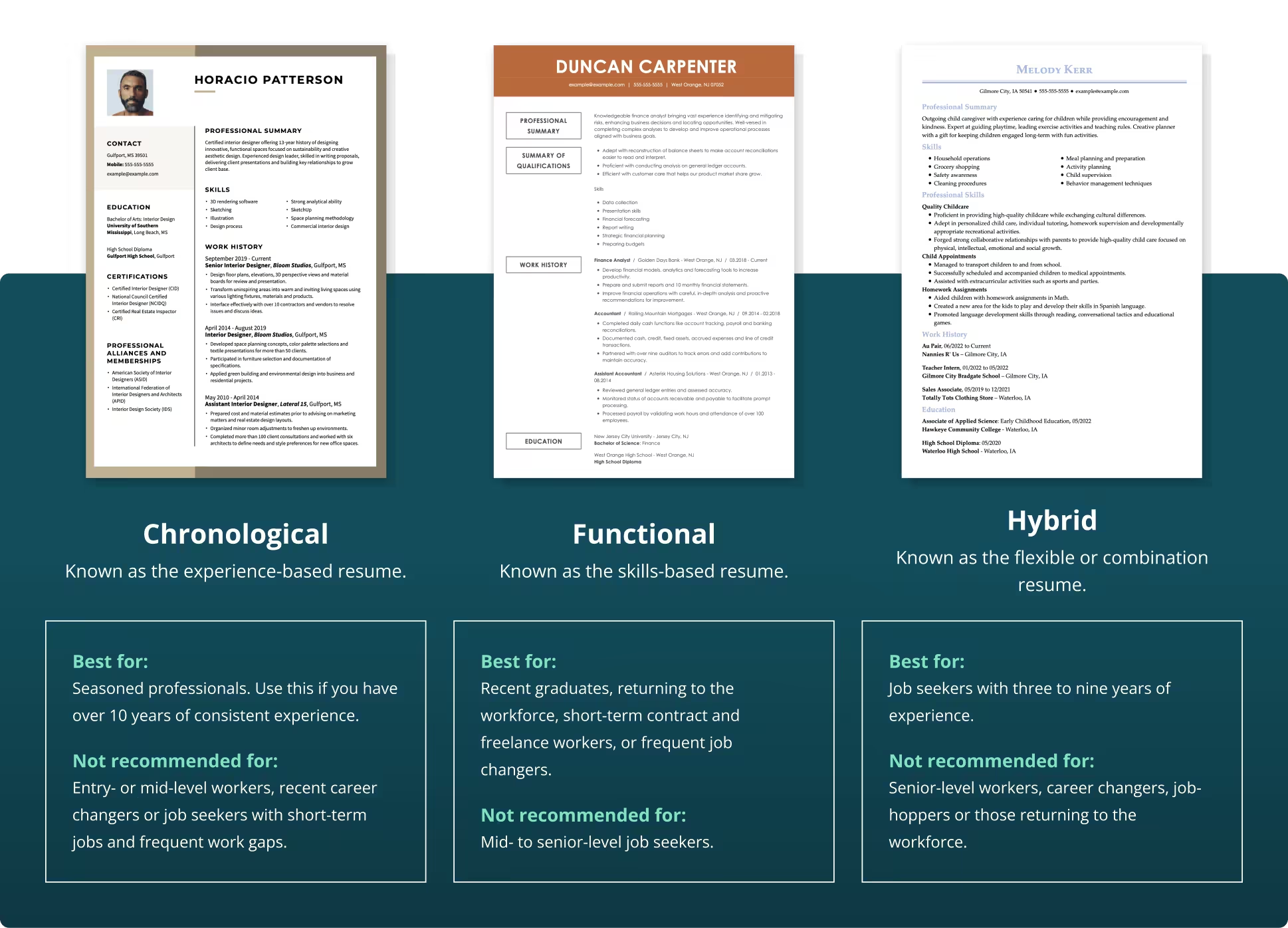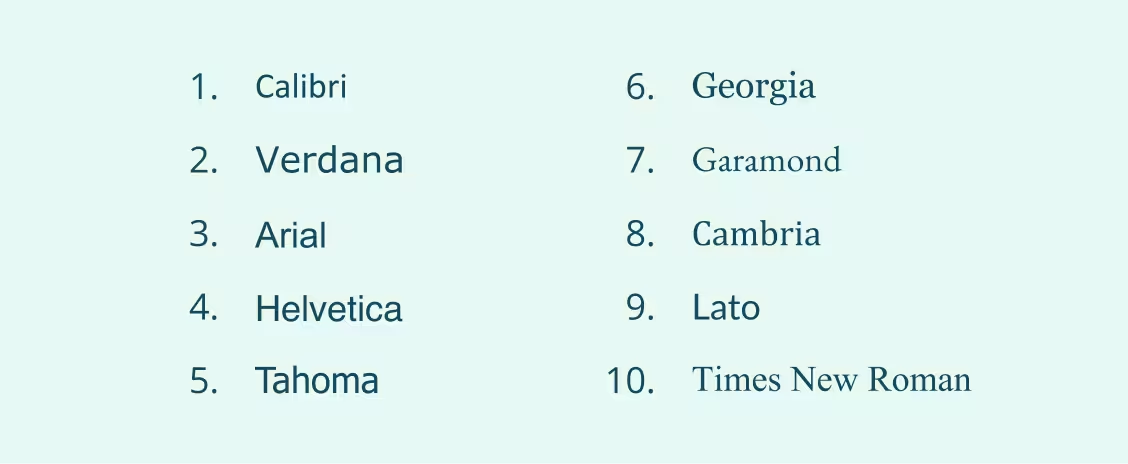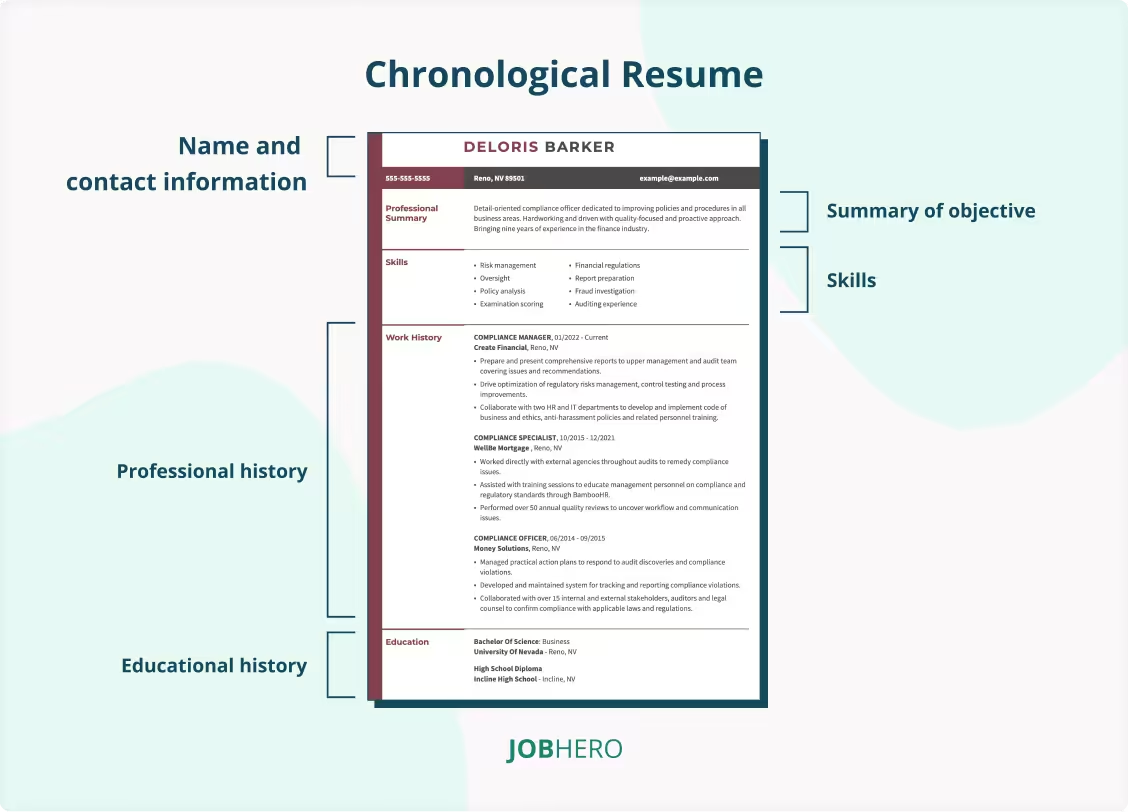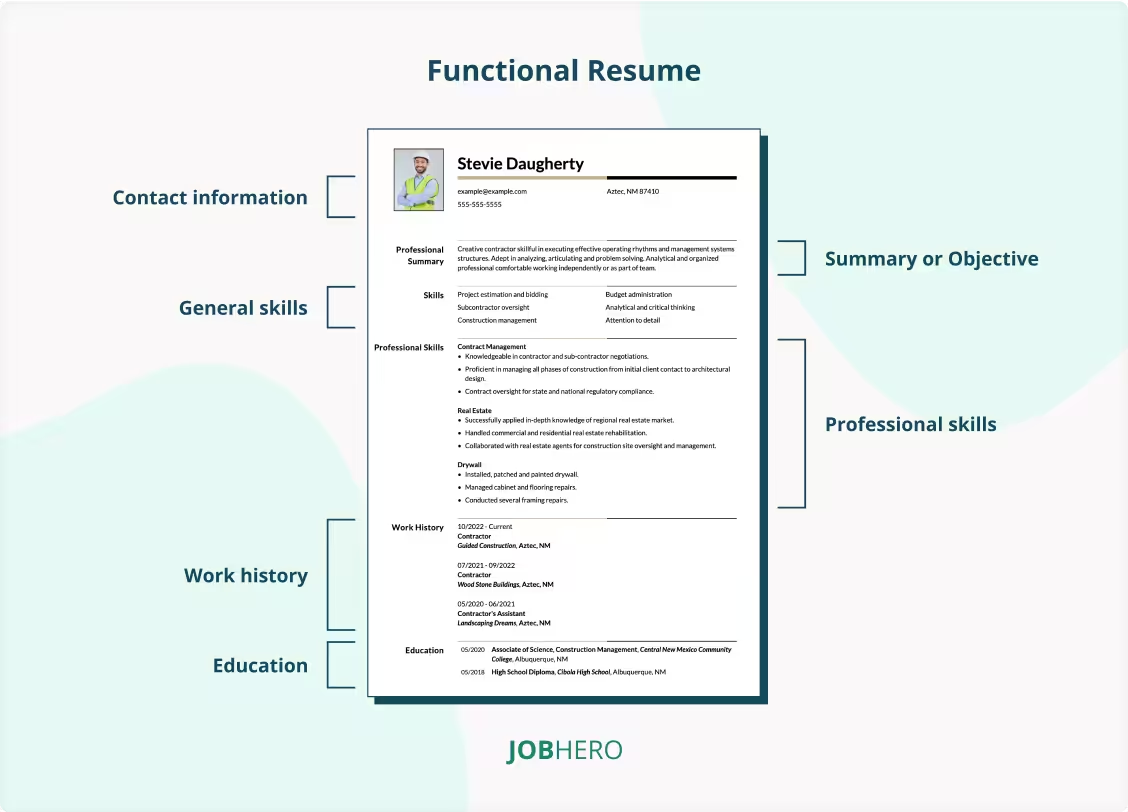What Are Resume Formats?
The three types of resume formats are chronological, functional and hybrid resume.
1. The chronological resume format focuses on work history, lists jobs in reverse order, and is best for job seekers with 10 or more years of experience.
2. The functional resume format emphasizes skills and accomplishments and works best for career changers, those with employment gaps and recent graduates.
3. The hybrid resume format combines the best of both formats by giving equal emphasis to skills and work experience.


PRO TIP:
The phrase “resume formats” differs from “resume formatting.” Resume formats refer to the strategic outline you use to describe your qualifications. Resume formatting refers to design choices related to fonts, margins and paragraph structure. We’ll cover resume formats first, followed by proper resume formatting tips!
How to Format a Resume
Before we dive into how to pick the proper resume format for your experience level, let’s cover these resume formatting essentials to make sure your information isn’t cluttered or hard to read.
Fonts
A simple font makes it easy for hiring managers to quickly read and understand your resume formats.
- Use a standard font like Arial, Aptos, Cambria or Times New Roman.
- Avoid handwritten fonts like
 or
or  .
. - These fonts require more mental energy to decipher.
- Set your font size between 10-12 points and stay consistent. The only information that should be a bigger size is your section headings.
- Use a 14-18 point font size for your section headings and use the same consistent size throughout your document.
Check out the following standard fonts:


Margins
Margins create a visual frame around your qualifications and add whitespace around your dense resume sections. This balance between text prevents eye strain and helps hiring managers easily move from one line to another.
- Use standard 1-inch margins on all sides.
- Go as small as half-inch margins if you need more space for a one-page resume.


Resume sections
Organize your qualifications into standard resume format sections so hiring managers can quickly trace your work history, training or technical knowledge. The different resume formats feature unique resume sections but will include the following standard sections:
- Contact information
- Summary statement
- Skills
- Work history
- Education


Section headers
Format your resume with clear section headings. These visual markers help hiring managers quickly search your resume for relevant information. Make your section headings clear by:
- Using a larger font size or special treatment like bold text.
- Using design borders to create visual breaks throughout the resume.
- Adding an extra line break before new sections to create whitespace between sections.
- Using a single color to mark each section.
- Using a free resume template with predesigned section headings.


Bullet points
Short bullet points or numbered lists make it easy for hiring managers to read and understand your accomplishments quickly.


Line spacing
Line breaks between your sentences also help create whitespace and natural borders between each line.
- Use single or 1.15 line spacing within each resume section to pack the most information in your one-page resume.
- Use 1.5 or double line spacing between resume sections to create a break between your qualifications.


File format
Different operating systems can reformat or resize your resume, making it hard to read. To minimize this risk, save your finished resume as a PDF file.
Create a standardized document in our award-winning Resume Builder.


How to Pick the Best Resume Format
Consider your unique career situation and level to decide which of the different resume formats works best for you.
Let’s walk through the types of resume formats to learn how to pick and write each one.
Chronological resume format
The chronological resume format uses a reverse-chronological work history to share your past jobs, steady job growth and commitment to your career. This resume format is best for candidates with over ten years of experience in a dedicated career path or industry. Use this format for management and senior positions.
A chronological resume includes these resume sections in this order:
- Name and contact information.
- A summary statement.
- Professional work history.
- List of skills.
- Education.
 Pros
Pros
To make the most of this resume format:
- Use short, detailed bullet points that managers can quickly skim and process.
- Add quantifiable information based on your best accomplishments.
- Start with your current or most recent job and focus on promotions and career advancements.
 Cons
Cons
Don’t use this resume format if:
- You have less than 10 years of experience. You’ll need more space to highlight relevant skills
- You’re a new job seeker. The detailed work history highlights your lack of employment history.
- Rejoining the workforce. These employment dates make it easy to spot work gaps.
- Changing careers. There’s no place to add context to your transferable skills outside of the resume objective.
Functional resume format
The functional resume format is skills-focused rather than career-based. This highly customizable resume is the best format to showcase your transferable skills and work-related training. Use this format if you have zero to three years of formal job experience.
As the most customizable resume format, a functional resume can include these sections:
- Name and contact information.
- Resume objective.
- Summary of qualifications.
- Professional skills.
- Work history.
- Education.
Additional optional sections:
- General skills.
- Digital skills.
- Additional skills.
- Languages.
Since this customizable format goes against ATS best practices, use this format on job boards with detailed questionnaires about your work history, like Workday. These job boards use your resume and cover letter as supplemental information to add context to your answers.
For most online applications, use an ATS resume format like the hybrid and chronological resumes, or run your functional resume through our ATS Resume Check to see how these programs rank it.
 Pros
Pros
How this format works:
- It works best for recent high school and college graduates, career changers, people returning to the workforce and people with informal experience.
- Highlights relevant skills from development opportunities like volunteering, hobbies or training programs.
- The customizable design means you can create multiple detailed sections for transferable skills.
 Cons
Cons
Don’t use this format if:
- You have over three years of experience, especially if you have more than one job.
- Applying for a promotion — your resume should show career growth over time.
PRO TIP:
Since this customizable format goes against ATS best practices, use this format on job boards with detailed questionnaires about your work history, like Workday. These types of job boards use your resume and cover letter as supplemental information to add context to your answers. Use an ATS resume format like the hybrid and chronological resumes for most online applications.
Hybrid or combination resume format
A hybrid resume format, also known as the combination resume, combines the best parts of the chronological and functional resume formats and is organized to highlight both your skills and work history.
This format showcases your job-relevant skills and employment history with a clear timeline. We recommend this resume format for job seekers with three to nine years of experience, career changers or those applying for a promotion.
The hybrid resume with always include these resume sections in this order:
- Name and contact information.
- Summary statement or resume objective.
- Skills.
- Work history.
- Education.
 Pros
Pros
How this format works:
- Outlines growth, skills development and employment history.
- Highlights promotions and professional development.
- Easy to read and find information under clearly labeled headings.
- A great fit for military personnel moving to civilian jobs–they can highlight transferable skills.
 Cons
Cons
Don’t use this format if:
- You frequently change jobs. The focus on your work history highlights work gaps or constant job changes.
- Have over 10 years of experience. Focusing equally on skills and work history can make your resume too long.
Why Use a Resume Format Template?
Writing a resume can be pretty overwhelming. However, you can build a professional and powerful resume in no time with a preformatted resume template.
There are tons of benefits to using a template to create your resume. Let’s highlight the top six reasons why JobHero’s preformatted templates will work for you.
Impressive layouts
Dozens of resume templates with pre-formatted spacing and fonts to impress recruiters before they meet you.
Automatic formatting
Templates in the hybrid resume format include customizable sections you can move around without breaking the formatting.
Predesigned borders, font sizes and margins to finish your resume faster.
User-friendly
JobHero’s resume templates are easy to use. Simply answer the questions based on your experience and industry and follow the prompts to complete each part of your resume.
Auto-generated text suggestions
Our templates suggest keywords, prewritten job descriptions and job-specific sentences to explain your skills, experience and accomplishments.
ATS-friendly
Applicant tracking systems (ATS) are automated software employers use to scan resumes for relevant keywords.
Our templates use ATS-compliant formats and resume sections to boost your scores.
Our builder suggests specific keywords to meet industry standards.
What Customers Have to Say About Our Builder
Resume Formats FAQ
Which format do most employers prefer for resumes?
When in doubt, use the chronological resume format. This resume format follows the most familiar outline to deliver your previous job history, accomplishments and related education.
Recruiters also prefer this format because its neat timeline makes it easy to follow your career progression. The reverse-chronological resume format is:
- Easy to read.
- ATS-friendly because it is easy to scan.
- Highlights your professional achievements.
How far back should a resume go?
The best resume writing rules are that you should have one page for every decade of experience. Unless you’re applying to a leadership position, you should only focus on the last 10 years of experience to keep your resume to one page.
Can I change my resume format in JobHero’s builder?
Yes. JobHero’s Resume Builder auto-generates a combination resume based on your answers, but you can easily create sections, drag and drop information, and personalize your resume. The builder will also check your resume for common typos, wordy descriptions and relevant skills to help you pass ATS.
Step 1: Find a template and click it to edit.
Step 2: Personalize the template with your career experience, font choice and colors.
Step 3: Drag and drop sections to tell your professional story.
What are the best resume formats for students?
The functional resume is the best resume format for high school or college students. This format prominently focuses on skills and education.
A functional resume puts your academic achievements as your most marketable highlights. You can highlight volunteer work, expected graduation date, awards, recognitions and internships. This format also helps you downplay your lack of relevant work experience.







